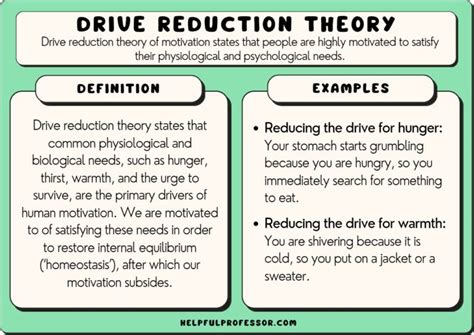In the realm of psychology, the drive reduction theory stands as a fundamental concept in understanding human motivation. This theory proposes that individuals strive to reduce internal states of tension or discomfort, known as drives, by engaging in behaviors that fulfill their needs.

Defining Drive Reduction
A drive is an internal state of psychological or physiological arousal that compels an individual to act. These drives can arise from various sources, such as hunger, thirst, or the need for social connection. When a drive is activated, it creates a state of tension or discomfort that motivates the individual to engage in behaviors that reduce this tension.
Role of Behavior in Drive Reduction
According to the theory, individuals are motivated to engage in behaviors that satisfy their drives and thereby reduce their internal tension. For example, if an individual is experiencing hunger (a drive), they will be motivated to eat food (the drive-reducing behavior), which reduces their hunger and the associated discomfort. This reduction in tension serves as the reinforcement for the behavior, promoting its repetition in the future.
Key Points of Drive Reduction Theory
- Drive: An internal state of tension or discomfort that motivates behavior.
- Behavior: Goal-directed actions aimed at reducing drives.
- Reinforcement: Positive consequences (i.e., drive reduction) that increase the likelihood of repeating behaviors.
- Homeostasis: The tendency of biological systems to maintain a stable internal environment, including the reduction of drives.
Applications of Drive Reduction Theory
The drive reduction theory has found applications in various areas of psychology, including:
- Understanding Motivation: Drives serve as the underlying mechanisms behind human motivation, guiding behaviors that satisfy needs and reduce discomfort.
- Treatment of Addiction: Addiction can be viewed as a chronic state of drive activation, with behaviors aimed at reducing cravings and negative emotions.
- Intervention Strategies: The theory can inform intervention strategies for individuals struggling with harmful behaviors, such as substance abuse or compulsive eating.
Common Mistakes to Avoid
- Oversimplification: The drive reduction theory is a simplified model of motivation, and it may not account for all factors influencing behavior.
- Ignoring Cognitive Factors: The theory primarily focuses on physiological drives and behaviors, but it underemphasizes the role of cognitive processes in motivation.
- Lack of Predictive Power: The theory does not always provide precise predictions about specific behaviors, as individual differences and environmental factors can influence actions.
Pros and Cons of Drive Reduction Theory
Pros:
- Provides a clear framework for understanding motivation.
- Supports research on biological basis of behavior.
- Has practical applications in therapy and intervention.
Cons:
- May oversimplify human motivation.
- Does not account for all types of behaviors.
- May not predict behavior in all circumstances.
Tables for Further Understanding
| Drive | Associated Behavior | Drive Reduction |
|---|---|---|
| Hunger | Eating | Reduction of hunger pangs |
| Thirst | Drinking | Quenching thirst |
| Sleep Deprivation | Sleeping | Rest and recovery |
| Social Isolation | Social Interaction | Feeling of connection |
| Common Mistakes to Avoid | |
|---|---|
| Overgeneralizing the theory | |
| Ignoring cognitive factors | |
| Expecting perfect predictability |
| Applications of Drive Reduction Theory | |
|---|---|
| Intervention strategies for addiction | |
| Treatment for compulsive disorders | |
| Understanding the biological basis of motivation |
Conclusion
The drive reduction theory is a classic theory in AP Psychology that provides a fundamental understanding of human motivation. By proposing that individuals engage in behaviors that reduce internal tension, the theory offers a framework for explaining and predicting a wide range of goal-directed actions. While it has limitations and should not be oversimplified, the drive reduction theory remains a valuable tool in understanding the complexities of human behavior.
